You may not find this terribly rewarding unless you're included here, so this is a good time for casual and random browsers to turn back before they get too caught up in the sweep and majesty of the proceedings and can't let go.
We've been wandering all round the Capodimonte museum -- or, some of it, rather; there's too much there to be thorough -- and now it's time for a stroll back downtown and of course a little lunch.

The first step is to figure out which way to go.
(We came up in a taxi and were nodding off at the time.)

Here we are -- we remember this from our last visit. We're in the middle of the Giardini Principessa Iolanda, apparently. Not too gardeny at the moment.

This isn't going to be fun.

If this were a race, we'd already have lost it.

But as temporarily painful as it might be, it's still arguably better than going uphill.

Off the 'Gradini Capodimonte' and around the 'Tondo di Capodimonte'

That's the top end of the Basilica di Santa Maria della Sanità -- it's the centrepiece of a large neighborhood and piazza down below; we're on a kind of overpass at the moment, the Ponte Maddalena Cerasuolo.

Nothing that a good coat of paint could do wonders for. We're still on the Via Santa Teresa degli Scalzi (St Teresa 'of the barefoot', probably a long story there), which in time will become, after the Piazza Dante, the famous Via Toledo.
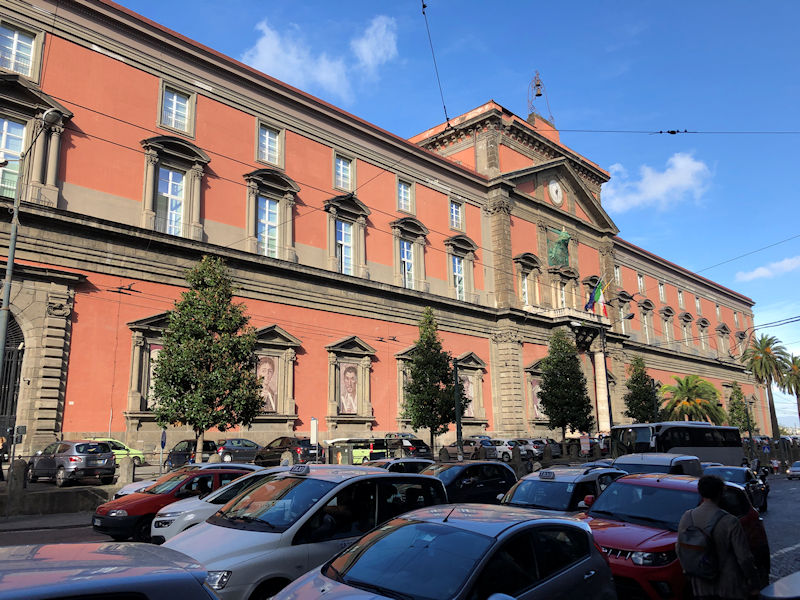
Our first landmark is the National Archaeological Museum -- we'll come back in a day or two, now lunch is taking precedence.

Across the street from the museum, life goes on.

There's another gallery, facing the archaeological museum across the Piazza Museo, a smaller version of the Galleria Umberto I down by the port.

It's the Galleria Principe di Napoli, built between 1873 and 1883; the façade collapsed in 1965 but was fixed up by 1969, and then thoroughly renovated and reopened to the public in 2009.

It apparently never fulfilled the commercial dreams had for it, with mostly administrative offices and what not, but it's still very beautiful (if you really like these galleries).

One problem they'd had in the past was that, in the absence of suitable playgrounds in the neighborhood, the local kids were using it as a football field and had knocked out all the lighting globes. That problem seems to have been solved now.

This is the Accademia di Belle Arti di Napoli, a half block below the Galleria and facing our lunch table in the street in front of the Volta espresso bar with fast pasta.

Awaiting lunch (not as fast as advertised), we're well entertained.

The Japanese students of the Academy, we were informed by the luncheon staff, have a ritual of celebrating each of their recent graduates by setting off loud confetti bombs. The neighborhood commercial staff are left to clean it all up, and are displeased.

Our mission now is to sign up for tickets to the tiny Museo Cappella Sansevero, famously crammed full of wonderful 18th century religious works by masters of the era, but admitting only 20 viewers at a time.
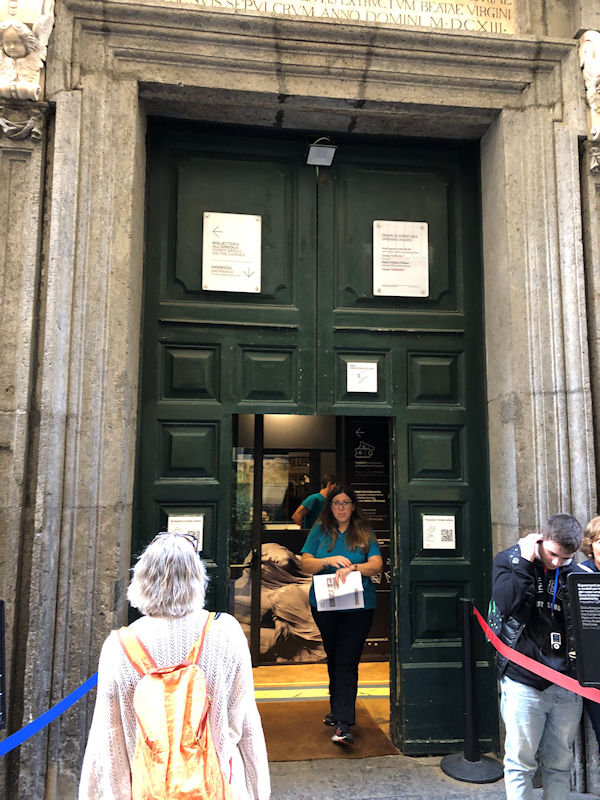
Kristin is our most enthusiastic seeker after famous 18th century religious beauties, but was shunted off to the following day by some fairly unpleasant staff.

So in the meantime, we're devoting our time to this central neighborhood, bisected by essentially pedestrian streets, some with (as here) a harp player on the sidewalk.

Through the courtyard, it's time for the Chiesa di San Domenico Maggiore ('opulent church with frescos & tombs').

'Opulent' isn't always a good thing in religious matters -- the Dominicans, after all, were supposed to be mendicant preachers, apostolic poverty, heretic hunters, earnest Inquisitors, that sort of thing.

Oh no, not another one.

That's really a bit over the top. Who needs to see that sort of thing right after breakfast?

It's very big, and high, and yes, 'opulent'.

If those fellows (and ladies) were really mendicant, they must have been very good at it indeed. In any case, the present church was begun by Charles II, the Angevin King of Naples (etc. etc.), in 1283 and completed by 1324 in what was known as the Gotico Angioiano in Italy (not the same as the Angevin Gothic style in France), though it has been modified frequently. In fact, it was Baroquized in 1670, but that was re-Gothicized in the 19th century.

This is the Brancaccio Chapel, largely frescoed by the Roman Pietro Cavallini in 1308/1309.

That's Cavalini's Mary Magdalene in the lunette top frame, hair-covered in one of her iconic guises, and apparently in some kind of a cave. (One version of her medieval story is that she was transported to southern France, converted everybody to Christianity, and then retired to a cave somewhere in Provence.)

The pulpit

A side chapel
Thomas Aquinas came back to teach theology in the attached monastery in 1272 and, in fact, was seen levitating before an icon of crucified Christ, who thanked Thomas for writing so well of him all those years and asked him what he wanted in thanks, and Thomas replied 'Just you".
Giordano Bruno also lived here for a while but then moved along -- the Inquisition caught up with him eventually, of course, and burnt him up in Rome in 1600.

The main altar

Another view of the altar, with apparently one of two crypt stairways, guarded by lion statues and an unwelcome saggy rope. In the sacristy, we're informed, there is a series of 45 sepulchres of members of the royal Aragonese family, including a whole bunch of royal hearts that were lost when the French army bounded in in the early 1800s.

In the end, we conclude that 'opulent' is definitely the right word, and perhaps 'how much is enough?' might be the right question.

Here's the apse-end of the Dominican church, very fortress-like, perhaps with good reason. It's backing onto the Piazza San Domenico Maggiore, which in turn is facing onto one of the three chief east-west streets of the original Greek city of Neapolis, in this part of it called the Via Benedetto Croce. Most of the streets in this part of the city centre are largely restricted to pedestrian traffic.

A lively piazza, with all kind of commercial activities, like outdoor cafes, news and souvenir stands, and . . .
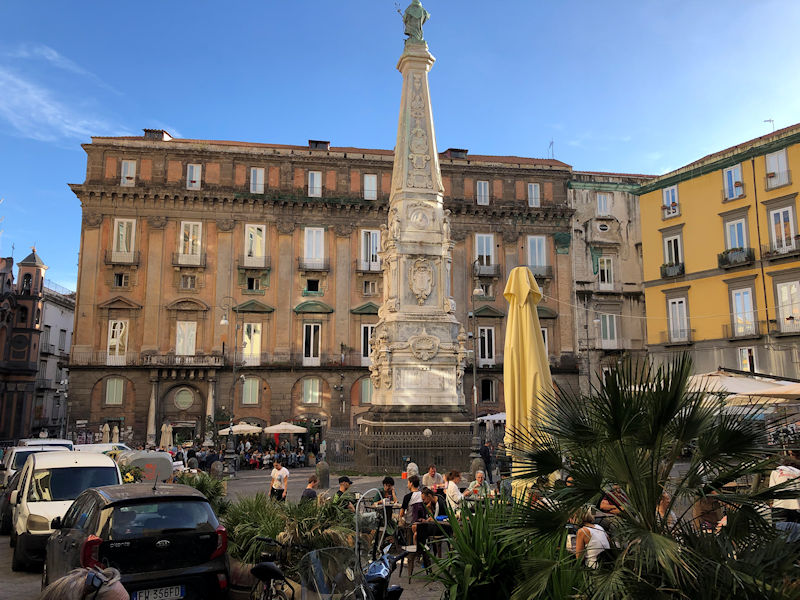
. . . an obelisk, one of three so-called 'plague columns' in the city, with a statue of St Dominic on top, which was set up after the plague of 1656.

That all looks so good that we're resolved to come back for lunch when our friends Cathy and Oscar arrive.
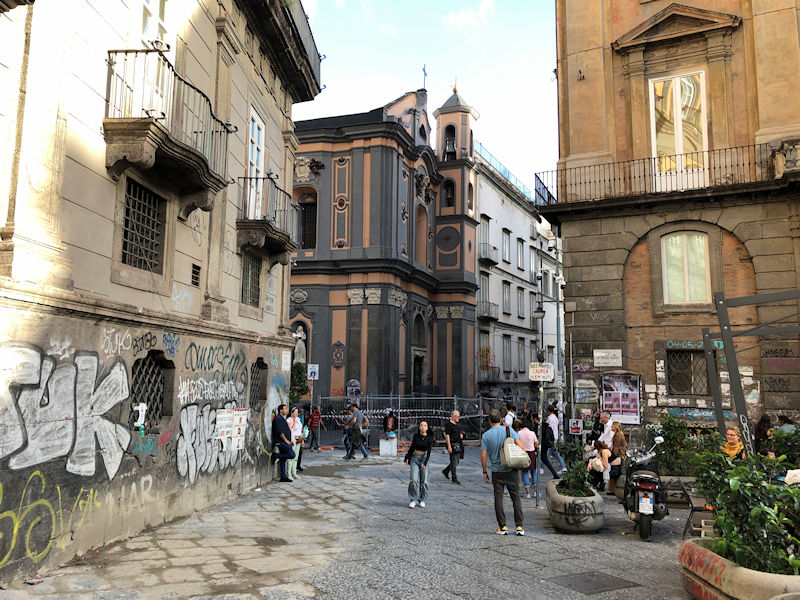
Squinting farther down the Via Mezzocannone from the Dominican piazza

And now we intend to drift off along the Via Benedetto Croce towards . . .
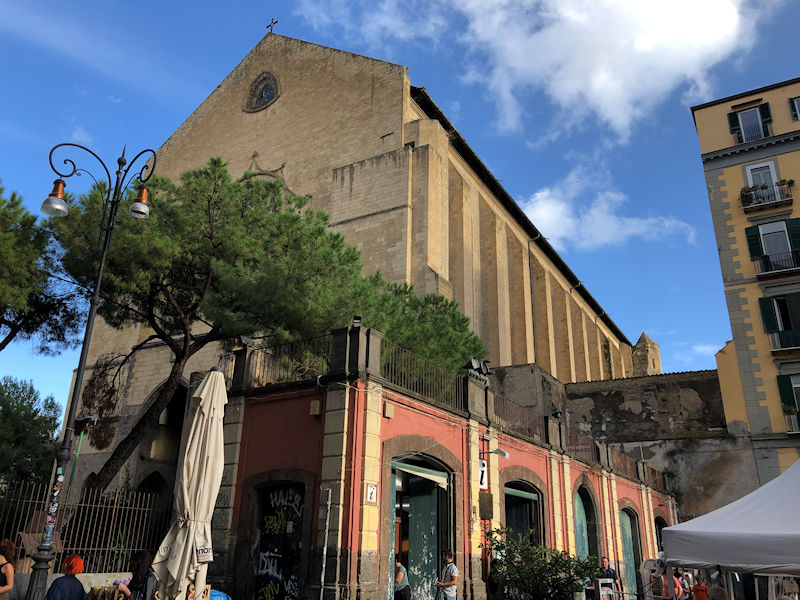
the Complesso Monumentale di Santa Chiara (St. Clara), comprising the Church of Santa Chiara, a monastery, tombs of worthies, built in 1313 to 1340 and redecorated in Baroque style in the 17th century, an archaeological museum, and its famous cloister festooned with painted majolica tiles of fanciful and rustic scenes. We'll come back to see the tiles again in a few days.
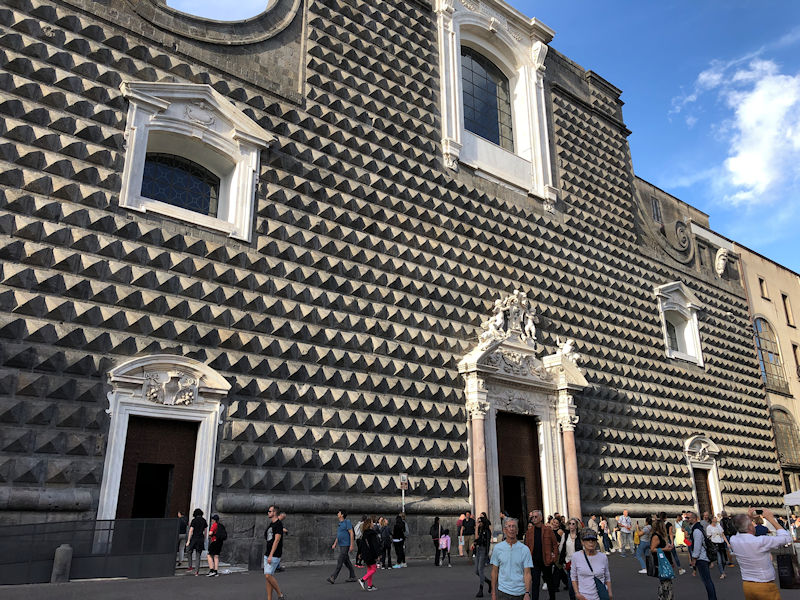
Facing the Santa Chiara complex is this Chiesa del Gesù Nuovo, with its ashlar diamond façade, built by the Jesuits in the late 16th century. We'll come back soon.
The façade is reminiscent of the Palazzo dei Diamanti in Ferrara, now the Pinacoteca Nazionale di Ferrara, covered with 8,500 of those things.

That's an 18th century construction called the Guglia dell'Immacolata (Spire of the Immaculate Conception).
The Piazza del Gesù Nuovo is officially the starting point of the 'Via Spaccanapoli', the 'Naples Splitter' street, that runs 2 km in a straight line to the east 'splitting' the old centre of town, called the Via Benedetto Croce at this end and a few other names farther on where it crosses the Via Duomo. It's the lowest of the three decumani (the Decumanus Inferiore), the main east-west streets of the ancient Greco-Roman grid of Neapolis. The central one, the main Decumanus Maggiore, runs parallel along what's now called the Via dei Tribunali, past the Duomo, and the northernmost runs along the Via della Sapienza roughly from the Academy of Fine Arts.
In the early 16th century, the city centre was expanded from this point westward under the Spanish viceroy Pedro Alvarez de Toledo, comprising what is now called the Quartieri Spagnoli or Spanish Quarter (then populated by members of the Spanish garrison) across the Via Toledo.

Political activism . . .

. . . it's good to see that some people still care.
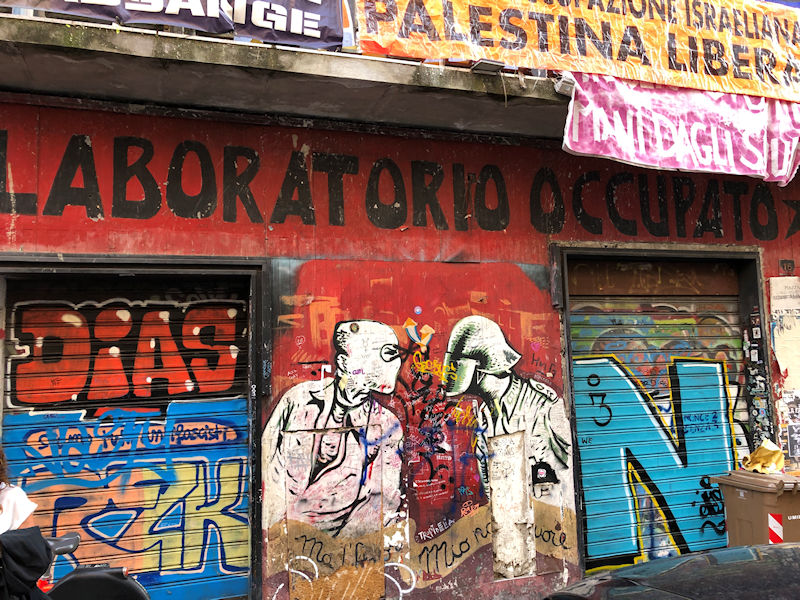

Still on the Calata Trinità Maggiore, leading to . . .
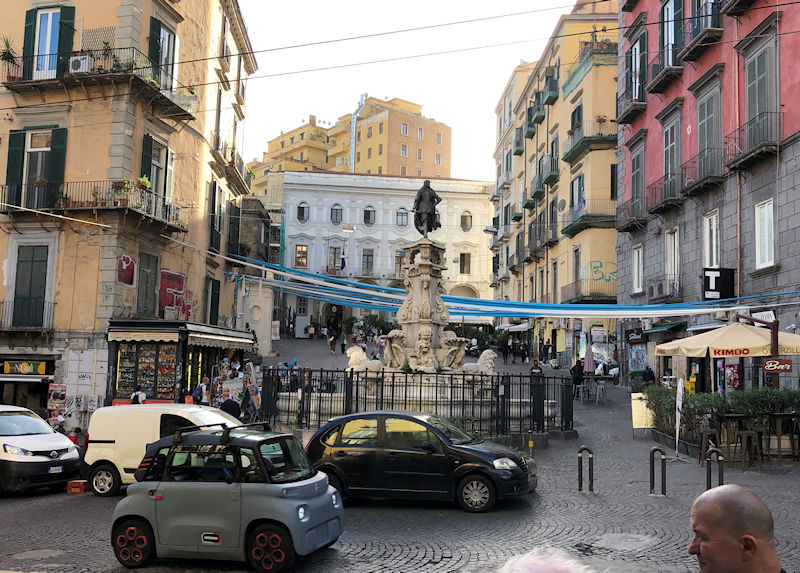
. . . the 'Fountain of Carlo II' across the Via Monteoliveto, near the Church of Sant'Anna dei Lombardi (which we'll visit soon).

The Fountain of Monteoliveto (1699), aka the Fountain of Carlo II (1661-1700), the last Bourbon King of Spain, who was followed by the War of the Spanish Succession (1701-1714).

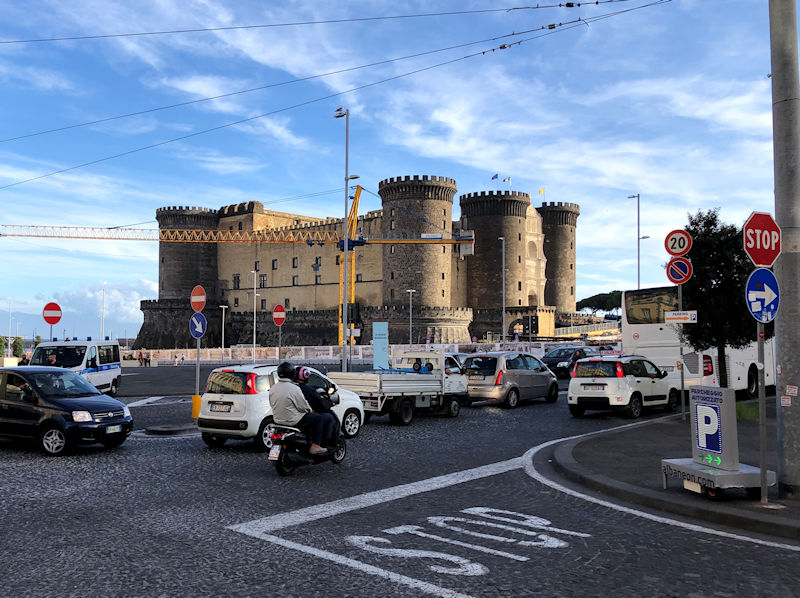
Emerging from the Piazza Municipio with another view of the Castel Nuovo, with . . .
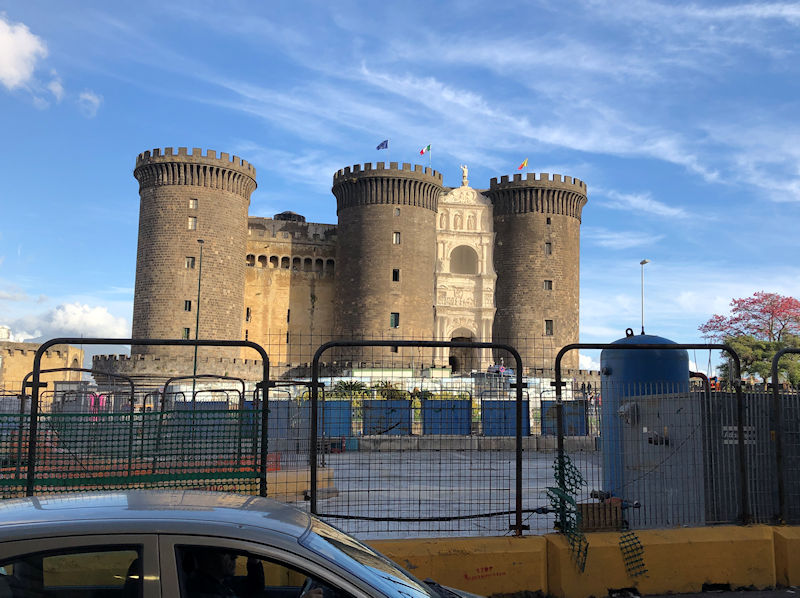
. . . lots of construction work going on all over the shop.

Heading home and passing the Galleria Umberto I . . .

. . . with a glance in.

The Royal Palace at the head, or foot, of the Piazza del Plebiscito

Watching for the excitement on Mt Vesuvius, if any today. (The operators of these two 'taralli caldi' stands, located on the Rotonda di Via Nazario Sauro facing Umberto I's statue, set out chairs on fine days to attract customers. [Taralli are small wheat-based doughnut shaped crackers which can have several flavors and be served hot or cold, hot in this case.])
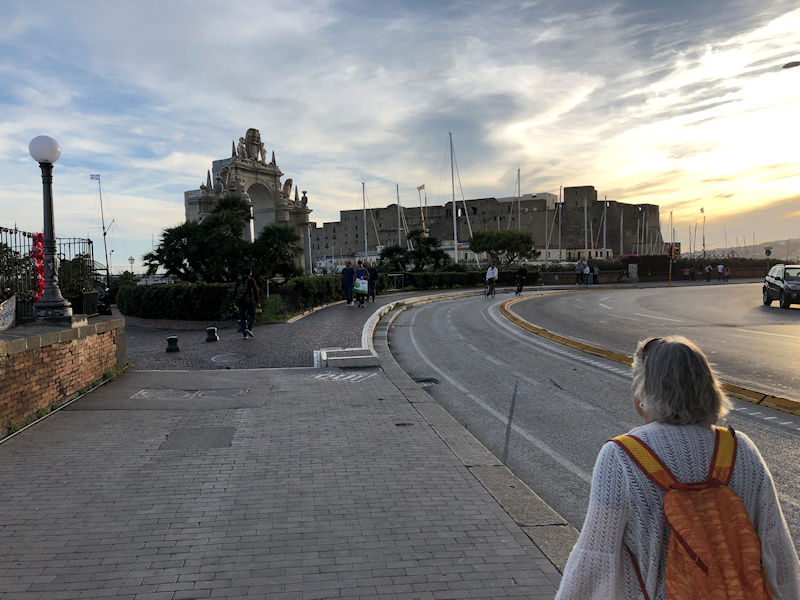
Back home, as it were

Early evening, time for chow . . .
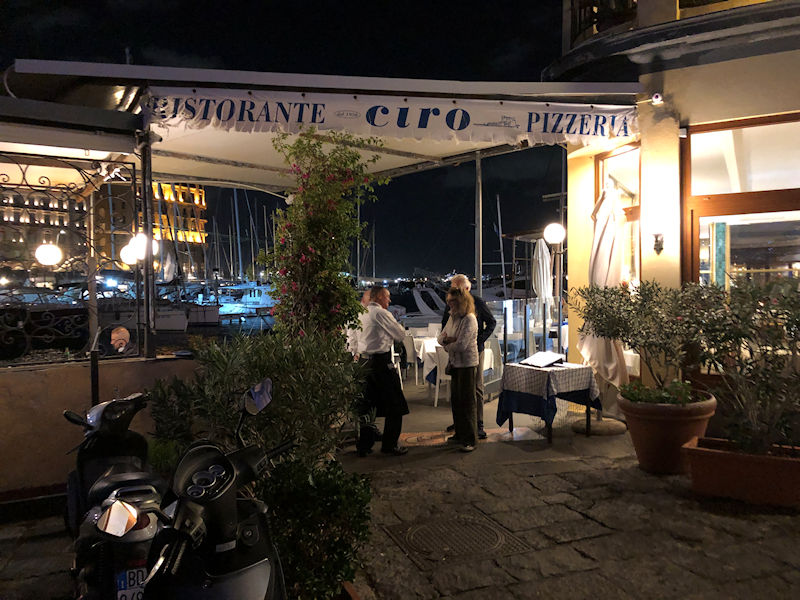
. . . at the nearby Ciro Ristorante, which we liked very much. We ate there on four nights, and on the first two, arriving early as we usually do, they seated us in the nearly empty diningroom next to another American couple, both of them very congenial.

Back to the flat, passing more restaurants (this is the one with which we had the bagarre over their mishandled heater).

No dinners here, but they provided life-saving takeaway pastries and coffee in the mornings.

This one, the Donna Lucinella, we tried on our last night; my notes just said 'great'.

The end of our road (oddly named Via Eldorado) and . . .

. . . in we go.

The night view from the balcony
Next up: The Galleria d'Italie - Napoli and the Castel Sant'Elmo


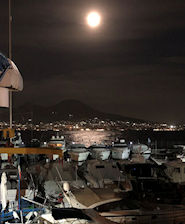 Dwight Peck's personal website
Dwight Peck's personal website















































































